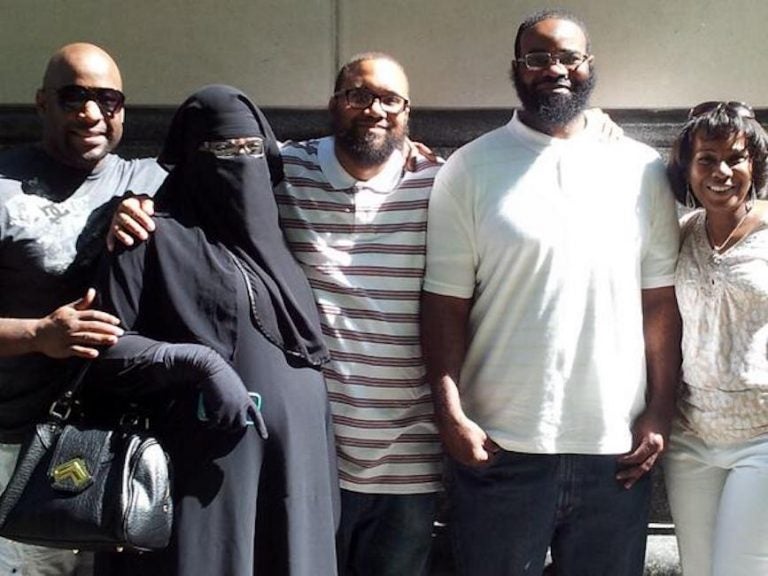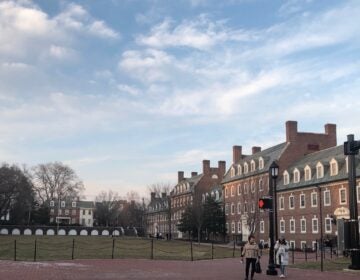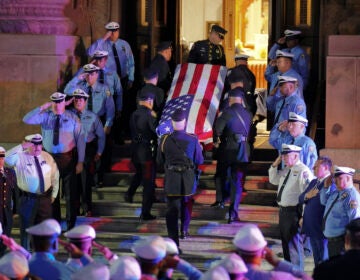After 16 years in prison, two men falsely accused in killing to share $3 million from Philly
Eugene Gilyard and Lance Felder spent 16 years behind bars until an inmate serving time for another murder confessed.
Listen 2:17
Eugene Gilyard (center) and Lance Felder (second from left) were exonerated in 2014 after spending 16 years in prison for a murder they did not commit. (Photo courtesy of the Pennsylvania Innocence Project)
A pair of 39-year-old Philadelphia men who spent most of their adult lives imprisoned after police falsely accused them of murder in the mid-1990s have settled for $3 million.
The city payout to Eugene Gilyard and Lance Felder is the result of a federal civil rights lawsuit filed against former Philadelphia police detectives who, according to the suit, coerced eyewitnesses to wrongly accuse the two and ignored other potential suspects.
After Gilyard and Felder spent 16 years incarcerated, an inmate serving time for another murder confessed — vindicating the duo and persuading prosecutors to drop their case against them.
On July 5, federal Judge Mark Kearney ordered that the civil suit seeking damages and a jury trial be dismissed following a settlement conference.
Under terms of the deal — provided to WHYY by sources close to the negotiations — Gilyard and Felder each will be awarded about $900,000 while the remaining money will cover attorney and legal fees.
Mike Dunn, a spokesman for the city, would not comment beyond stating that the agreement could still be subject to change.
The homicide
On Aug. 31, 1995, North Philadelphia businessman Thomas Keal, 52, was robbed and shot to death around 2:30 a.m. as he walked home from his bar and seafood store on North 17th Street.
After authorities failed to arrest any suspects for two years, detectives Dennis Dusak and John Benham reopened the case.
During an interview with a witness at police headquarters, the lawsuit claimed, Dusak placed a hand on the head of the witness and pushed his face toward a photo array and yelled, “Take a closer look!”
Dusak then tapped the mugshot of Felder and said, “We know he did it,” the suit continued.
The suit said the detectives told the witness that he would receive a cash payment if the man he identified was convicted.
The witness, Keith Williams, signed a statement saying that while sitting on the stoop of his house, he remembered Felder as one of the men running away from the murder scene. A man who was sitting with Williams gave police a similar account.
Another key witness for authorities was the victim’s daughter, Tonya Keal, who, according to the suit, could not pick Gilyard out of a photo lineup just days after the murder.
Almost three years later, Keal said she glimpsed Gilyard through the blades of a motionless window fan for about five seconds in early-morning darkness from her apartment above her father’s seafood shop. She told police she remembered him as “the fidgety guy with the bandana and the shotgun.”
With the absence of any physical evidence, the prosecutors’ case rested solely on the eyewitness accounts. In December 1998, a jury convicted Gilyard and Felder of murder, and the two, both 18 at the time, were sentenced to life without the possibility of parole.
All of their appeal attempts were denied.
The breakthrough
In 2009, inmate Ricky Wellborn confessed that he and another man he refused to identify actually killed Keal.
Gilyard’s family hired a private investigator to interview Wellborn in prison, and the information was sent to the Pennsylvania Innocence Project, which agreed to take on the case.
Through months of investigation, the group was able to show that the witness testimony contained conflicting accounts. The group discovered that authorities never explored the inconsistencies, nor did police look into whether Wellborn was the killer, as some witnesses had said.
The group found additional support, including witnesses who were not included in the trial, to back up the account of Wellborn, who went by “Rolex” on the streets. Witnesses said that Wellborn and an accomplice, who went by “Tizz,” were the real killers.
Gilyard and Felder had long maintained their innocence. At the time of the murder, Gilyard said he was at a nearby Chinese restaurant. He heard the shots and saw two men running away, but he said he could not identify the shooters.
Both men are still living in Philadelphia and working full time to support their families.
“They will never fully recover,” said Marissa Bluestine, executive director of the Pennsylvania Innocence Project. “They will not be able to have that whole life that they were looking for when they were so young, but this does go a long way in helping to close that gap.”
A judge vacated their convictions in October 2013, and the two men were released a month later. Shortly after, prosecutors decided not to retry the men.
Police “chose not to investigate and seek out the real killers even though they had been given the identities of the real killers,” wrote defense lawyer John Wendell Beavers, who declined to comment further.
New precautions
The department now uses “double blind” photo arrays where neither witness nor questioning officer knows who the real suspect is, said Francis Healy, a legal adviser to Police Commissioner Richard Ross.
And the photos are presented to a witness one at a time as a way of curtailing misidentification.
“It’s designed to eliminate potential investigator bias and designed to avoid witnesses from trying to compare and contrast pictures,” Healy said. “It’s leaps and bounds from where we were in the 1990s, that’s for sure.”
Philadelphia police, however, do not videotape witnesses looking through photos of suspects. That effort to keep the interaction with police neutral is mandated by some other jurisdictions, including New Jersey.
“Video is the way of the future. That’s something we will always look at, as well,” Healy said. “Identification is always a tough nut. The last thing we want to do as a police department is put the wrong person in jail That would break my heart to do that.”
Longtime criminal defense lawyer Jules Epstein, who represented Felder on appeal, said the identification reforms have shown progress in helping to root out false arrests. But he said the emphasis has often been on eliminating shaky stranger identifications.
In this case, the witnesses who provided erroneous identifications knew Gilyard and Felder, but Epstein said they felt pressured to find someone to blame for the murder of a businessman who was well known in the neighborhood.
“It certainly should have warranted a deeper look,” Epstein said. “Because anyone who went out to the murder scene, which I’ve done, and looked at where the eyewitness was, which I did, would have to question how much that person could have seen.”
WHYY is your source for fact-based, in-depth journalism and information. As a nonprofit organization, we rely on financial support from readers like you. Please give today.




